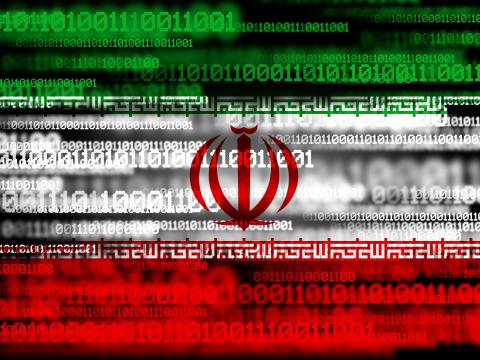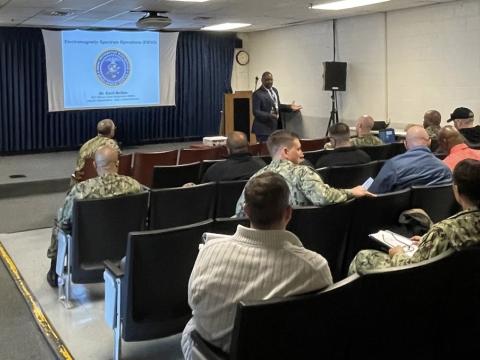Information Operations May Find Definition And Validation in Iraq
Military action could answer long-standing questions.
The debates over information operations have shifted from academia and Pentagon studies, military exercises and computer simulations to joint warfare over the sands of Iraq. This is the first opportunity to document and evaluate the role information actually plays in evolving military transformation into truly joint operations.
Operation Iraqi Freedom can yield answers to many persistent but illusive uncertainties and disputes, among which are the definition of information operations; where, by whom and when this form of warfare should be centrally controlled; what changes in organization are necessary; what tools are legally and morally acceptable; how information operations effectiveness can be measured; and, finally, to what degree—if at all—the infusion of information technology into smaller but more agile and lethal armed forces will validate the contention that information might substitute for physical mass and attrition.
The concept of information operations was born on ancient battlefields, briefly resurrected in the U.S. Defense Department as counter command and control, revived as information warfare and then changed to information operations after the 1991 Gulf War. By whatever name, the gist of information operations is both seductively simple and devilishly difficult to infuse into military doctrine and operational art. It is perhaps best defined by describing its objective: to cause a desired change in behavior of an adversary by targeting his mind rather than his body.
The concept of leveraging information to support or supplant combat was relatively straightforward in the ancient times of Sun Tzu when the tools of war were simple and wielded exclusively by kings and their armed warriors. However, the introduction of information technology has changed all that. Information operations tools are inexpensive, widely available for use by many on and far from a battlefield; the targets are both warriors and civilians; and many of the laws and rules that have governed armed conflict do not apply. The information operations sword can cut both ways.
Information operations have been described as a work in progress without an enterprise architecture. Nonetheless, experiences in Iraq will underwrite the greatest revolution in military affairs since the telegraph and railroad. The United States’ storied 8th Air Force already has become an information air force, swapping its bombers for platforms that will carry sensors, analysts, and communications equipment and personnel. Its commander, Lt. Gen. Bruce Carlson, USAF, has predicted that, within a few years, “you will see an intelligence or information operations or communications person, rather than a pilot, be the commander.”
However, as noted by Adm. James Ellis, USN, commander, U.S. Strategic Command, in an interview granted before the start of the war in Iraq, information operations must get beyond the “realm of a science project” and meet the “challenges of rates of success and dependability before it can claim to be a substitute for kinetics.”
These are some of the issues that may benefit from lessons learned in Afghanistan and in operation Iraqi Freedom:
• Did information technology systems dictate segregated rather than integrated joint operations? If so, does the fault lay with service doctrine or incompatible information technology? As this article is being written, what appears to be a hugely successful joint operation is nearing culmination in Iraq. Writing in the spring issue of Air and Space Power Journal, Gen. Richard B. Myers, USAF, chairman of the Joint Chiefs of Staff, described “segregated warfare” during Desert Storm and said the challenge for technology was to “allow joint commanders to integrate our services’ capabilities—not force commanders to deconflict them.” Meanwhile, the Pentagon is debating the need to strip the armed forces of their authority to furnish command and control systems, under Title 10, and vest that authority in the U.S. Joint Forces Command.
• Is an agreed definition of information operations really necessary, and must it be centrally managed? As the military services struggled to fold the explicit management of information into doctrine, the definition exploded to encompass organic service functions well-known, financed and managed—such as electronic warfare, operational security and psychological operations—with the new, unknown and ill-defined, computer network operations. The result was an all-encompassing mission area with no accountable management.
Bosnia and Kosovo were characterized as information operations failures—not all of which can be laid at the door of allies. The U.S. Air Force adopted a definition that distinguished the “old”—calling it information-in-war—from the “new”—the new being computer network operations and directed energy weapons. Some commands merged intelligence, communications and operations staff functions, and the military services are considering an information operations career field. In addition, information operations oversight has drifted in search of a home from the Joint Staff to a joint agency, then to the U.S. Space Command and now to the U.S. Strategic Command.
• How well did commercial information technology products and services stand up on the battlefield? Command and control of military forces as well as intelligence and logistic support is increasingly dependent on commercial information technology products and services. Concerns were raised over whether commercial products can adequately withstand the rigors of war; the ability of military training to cope with rapid and constant changes in technology; and the ability of an untested commercial logistic chain to provide 24-hour-a-day, seven-day-a-week and just-in-time support to the battlefield.
SIGNAL Editor in Chief Robert K. Ackerman, embedded with the 101st Airborne Division’s 501st Signal Battalion in Kuwait, reports that his ruggedized laptop functioned well during the sandstorms. Unfortunately, many U.S. Army units had little or no protected equipment.
• Did reach-back communications engender reach-forward control? Global wideband communications and the richly linked network of sensors gave physical substance to the concept of a common picture of the tactical battlefield that is shared with the operational and strategic levels of command. Reach-back allows large numbers of military support personnel to remain at their peacetime posts, remotely providing required services while reducing the footprint of deployed forces, and this capability is widely applauded. On the other hand, reach-forward permits senior command levels—many thousands of miles from the battlefield—to interject unhelpful suggestions and questions into tactical operations. This capability to micromanage combat—in the view of some Army and Air Force personnel who point to incidents in Desert Storm, Bosnia, operation Allied Force in 1999 and operation Enduring Freedom in 2001—threatens the time-honored doctrine of centralized planning and decentralized execution.
• Was information overload a problem? Richly interconnected sensors and virtually unlimited bandwidth—the essence of network-centric operations—can theoretically overload users with reams of unevaluated data that they cannot digest or use in a timely manner. If so, then information operations can increase, not reduce, the fog of war.
• Were significant interference and spectrum management problems encountered? The techniques to disrupt electronic emissions are well-known, and the tools are inexpensive and widely available. Russia is reported to have sold devices to disrupt the global positioning system, and reports from Iraq indicate such devices were found and destroyed. Growing dependence on electromagnetic emissions demands equal attention to management of the radio frequency spectrum. After-action reports from the 1991 Gulf War indicated that mutual interference, not enemy countermeasures, was the main culprit.
• How effective were psychological operations in winning hearts and minds? Was it radio, television and leaflets or words, water, wages or fear of Baath Party loyalists that dictated behavior of the Iraqi military, irregulars and civilians? Psychological operations are the oldest, least understood and most controversial of the many elements that were sucked up into information operations. They have been a useful tool in the military kit mainly because of a reasonable causal relationship with an observable effect, for example surrender of troops.
The picture is confused in Iraq because psychological operations were being employed in conjunction with overwhelming firepower by the military at tactical and operational levels, by the U.S. government at the strategic level and, in a wholly unanticipated way, by a host of embedded and free-agent journalists who were bombarding the public with real-time slivers of fact without context. Many decry psychological operations because they encompass propaganda, perception management, disinformation, lies, fraud and spoofing. But, as Winston Churchill said, “In wartime, truth is so precious that she should always be attended by a bodyguard of lies.” The dispute over psychological operations seems to arise when it moves from the battlefield into the strategic arena, with the controls being perceived as remaining in military hands. An example of this dispute was the aborted effort to form an Office of Strategic Influence within the Defense Department.
• Is a cyberattack a weapon of mass destruction, mass disruption or mass annoyance, or does it even matter? Did deployed military units experience any significant increase in probes into their information systems over that normally experienced at home bases? The U.S. invasion of Iraq has incurred the wrath of millions of individuals in the United States and around the globe, many of whom have launched attacks on the Internet against, among others, the White House and Al-Jazeera Web sites. Does this tell us anything for or against the thrust in the national strategy to secure cyberspace?
As the U.S. armed forces were packing for deployment last February, President Bush signed The National Strategy to Secure Cyberspace, noting that “national defense relies on an interdependent network of information technology called cyberspace.” That document has been dismissed by one critic as “bland public relations … that won’t help secure cyberspace,” while a supporter opines that it “champions a public-private partnership in collective responsibility to reduce vulnerability.”
Specification and critical assessment of all the information systems used in operation Iraqi Freedom can quantify the extent to which military operations are dependent on commercial cyberspace. In addition, it will yield some qualification of these dependencies, risks and vulnerabilities and, just perhaps, shed light on a federal policy that relies on exhortation and collective responsibility, rather than directives, regulation and funding, to secure cyberspace.
Col. Alan D. Campen, USAF (Ret.), is a contributing editor to SIGNAL and the contributing editor of four books on information and cyberwar.




Comments